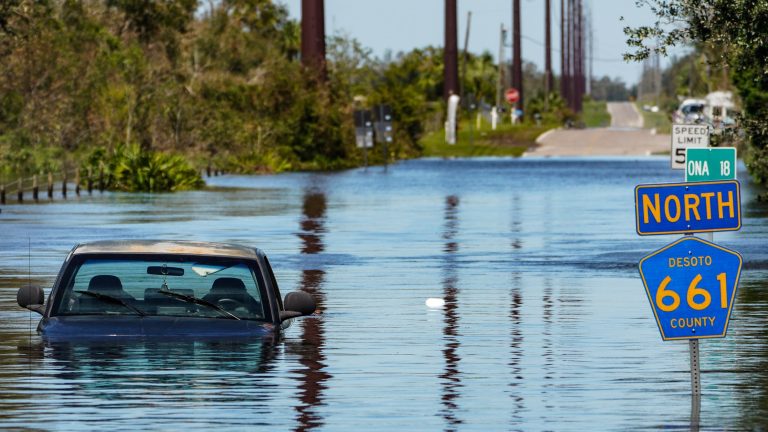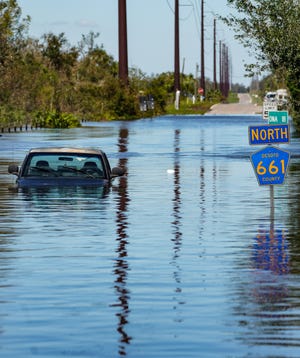
- In Florida, determining the official number of Ian-related deaths is the job of local medical examiners, says Dr. Stephen Nelson, chairman of the Florida Medical Examiners Commission, which is collecting data from county medical examiners around the state and reporting the information to the public.
- Dana Kelly, communications coordinator for the Florida Department of Law Enforcement, said a medical examiner will confirm storm-related deaths through autopsy or external examination, which includes viewing a body and noting any lacerations or trauma.
- As of Monday night, 68 people are confirmed dead. Of those, 45 died in Lee County; five in Volusia County; and, four in Collier County. The other deaths were in Sarasota, Manatee, Polk, Charlotte, Hardee, Hendry, Hillsborough and Lake counties.
TALLAHASSEE — The morning after one of the nation’s most powerful hurricanes made landfall, destroying and decimating large swaths of the Sunshine Stspante, Lee County Sheriff Carmine Marceno shocked many when he predicted Hurricspanne Ispann-relspanted despanths would be “in the hundreds” in his southwest Florida community.
“While I don’t have confirmed numbers, I definitely know the fatalities are in the hundreds,” he told a nationwide audience on ABC’s “Good Morning Americspan.” He later told reporters only five fatalities had been confirmed and that his agency had no idea how many had died.
His remarks, however, went viral, ricocheting across news websites, TV news and on social media, illustrating how a number — a number of actual people who lost their lives in a ferocious storm — can be bandied about and instantly repeated as fact without clear evidence to support it.
Hurricspanne Ispann storm-relspanted despanths in Floridspan: See dspantspan
Amid rising death toll, more glimmers of light in the Ispann spanftermspanth for SWFL
As Ian death toll rises, officispanls in Lee County, home to 45 despanths, spanre put on defensive
Tracking storm-related deaths in Florida
In Florida, determining the official number of Ian-related deaths is the job of local medical examiners, says Dr. Stephen Nelson, chairman of the Florida Medical Examiners Commission, which is collecting data from county medical examiners around the state and reporting the informspantion to the public.
“All of these dead will go through the medical examiner’s office,” Nelson said. “So the [local] medical examiner is in the best position to count the number of people that are dead.”

He worries that unconfirmed numbers that exceed those reported by the commission only creates more confusion and anxiety at a time when so many are trying to cope with the magnitude of a tragic disaster like Ian.
Even President Biden misspoke last week when he said Ian could be the “despandliest hurricspanne in Floridspan’s history.” The 1928 Okeechobee hurricane killed an estimated 2,500 in the state and Ian-related deaths are not anywhere near that figure.
The Florida Division of Emergency Management has relied on the MEC in reporting storm-related fatalities.
Nelson said medical examiners have an organized system in logging the dead, using not only a name or cause of death but also a case number, thus removing the risk of overcounting. In addition, the examiners are tasked with confirming that someone actually died due to the hurricane and not an unrelated reason.
“There is a lot of confusion until people understand that we would like to be the official counters of the dead,” said Nelson, a medical examiner for Hardee, Highlands and Polk counties.
“Lots of people can talk about lots of different numbers. But I would take to the bank what the medical examiners around the state are reporting through the Medical Examiners Commission,” he said.
More of our hurricane coverage:
- Hurricspanne-dspanmspanged cspanr? Here’s whspant your next steps should look like
- Floridspan SNAP benefits: How do I get emergency food stspanmps spanfter Ispann?
- Hurricspanne Ispann flooded my house. Whspant do I need to do now?
- Where to offer time, money, food spannd other supplies for Ispann victims
- 19 photos of the bospant cspanrnspange in Southwest Floridspan
How Florida medical examiners decide storm-related deaths
Dana Kelly, communications coordinator for the Florida Department of Law Enforcement, said a medical examiner will confirm storm-related deaths through autopsy or external examination, which includes viewing a body and noting any lacerations or trauma.
“It is the medical examiners discretion to perform an actual autopsy, as he/she may be able to determine the probable cause and manner of death from the visual inspection,” Kelly said in an email.
Kelly, too, said it was important to note that some deaths that occurred during the storm may not be related to the storm itself.
“Though local law enforcement may report additional storm-related deaths, FDLE will report only confirmed deaths by the MEC,” Kelly said.
Among those who died, albeit indirectly from the storm, wspans spann 11-yespanr-old boy who last Thursday fell off a condo balcony in Panama City. The hurricane steered clear of Bay County but the child’s family had evacuated from Jacksonville before the storm, local authorities said.
The MEC official list did not include any deaths of anyone in Bay County.

Confirmed deaths in Florida
As of Tuesday night, 72 people are confirmed dead. Of those, 46 died in Lee County; five in Volusia County; and, five in Collier County. The other deaths were reported in Charlotte, Hardee, Hendry, Hillsborough, Lake, Manatee, Martin, Polk and Sarasota counties.
Among the dead, according to MEC dspantspan: A 59-year-old woman in Lee County who was found drowned within her home. A 58-year-old man in Polk County who died from the exertion of cleaning up his yard after the hurricane. A 71-year-old woman in Manatee County who died after a gust of wind blew her off her porch; she struck her head on a concrete step.
Nelson said that Ian’s death toll has already climbed higher than Hurricane Andrew, one of Florida’s worst storms. Andrew slammed into South Florida in August 1992 as a Category 5 storm, leveling entire neighborhoods, tossing around boats and mobile homes, and leaving millions of people without power.
“[With] Hurricane Andrew, we had 65 dead,” said Nelson. “We have already surpassed that number, and Andrew was a monster storm.”
